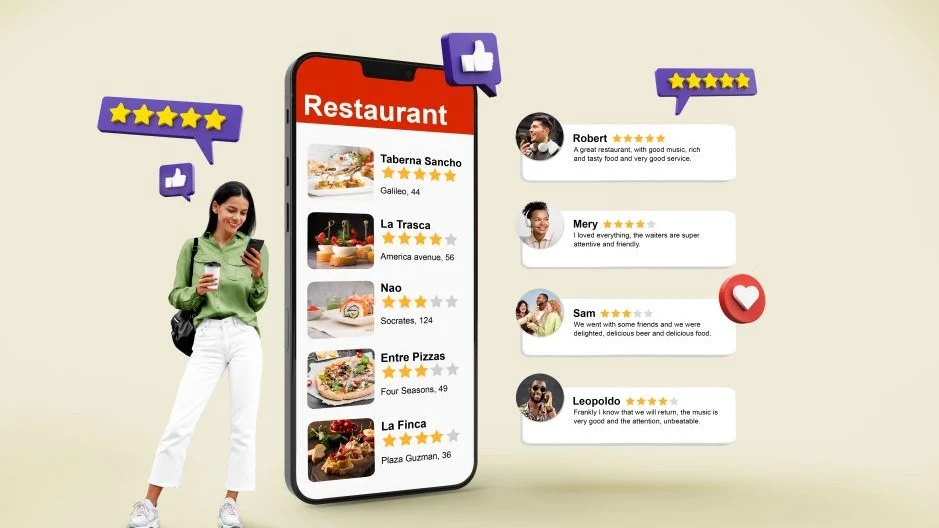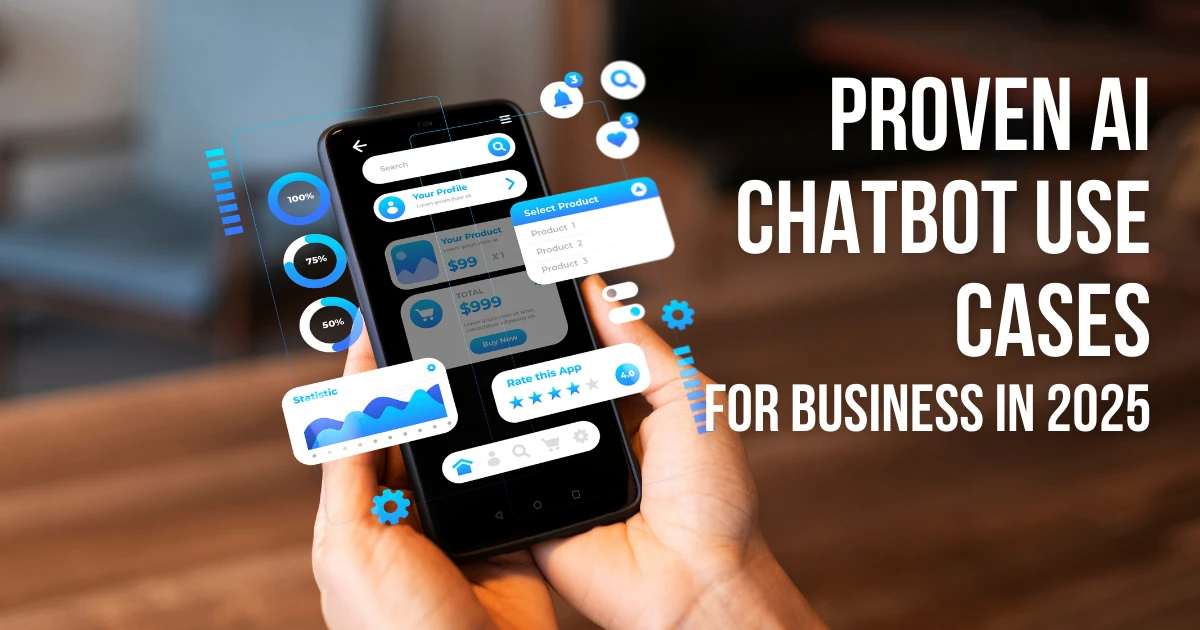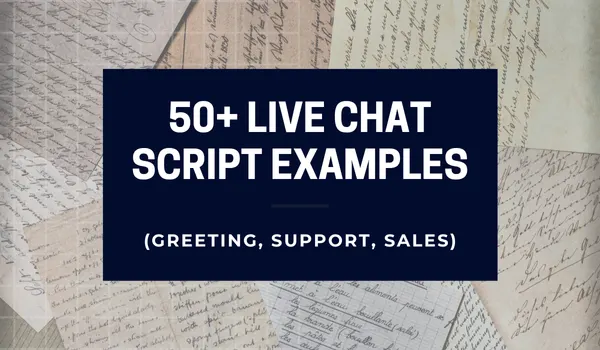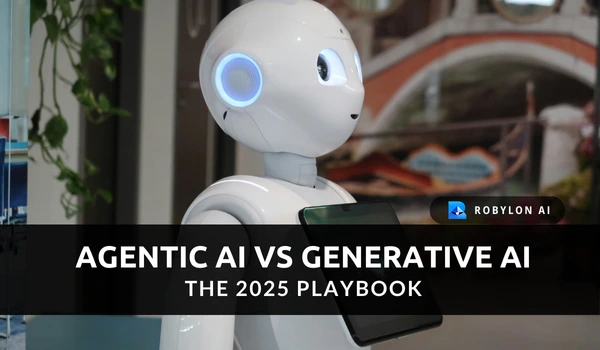Introduction: Why 2025 is the adoption year for conversational AI
Customer service trends 2025 can be summed up in plain English: teams are moving from agent-assist widgets to autonomous, integrated conversational systems that resolve issues end-to-end across web chat, WhatsApp, email, and voice/IVR. Modern platforms combine grounded knowledge, policy guardrails, and workflow actions (CRM, help desk, billing, shipping, RPA) to enable customers to achieve fast, consistent outcomes without manual intervention. For more on how chatbots work, see How Do AI Chatbots Work?
Conversational AI use cases move from pilots to production, and customer service chatbot use cases become an operating layer alongside your help desk and CRM. Quick proof sits in the ROI levers that operators track every week. First-contact resolution (FCR) increases as grounded bots handle top intents with policy-compliant answers.
This guide sums up a curated set of proven AI chatbot use cases in 2025, real-world chatbot examples (industry), and exactly how businesses use AI chatbots to hit targets.
Ready to take your AI chatbot further?
See how it can be connected with 40+ tools from CRMs and helpdesks to payment systems and analytics for seamless automation. Explore all integrations
Customer Service Chatbot Use Cases (core value)

Each use case relies on grounded knowledge (RAG), workflow/RPA to perform actions, and integrations with your help desk, CRM, billing, identity, and messaging channels. Success is tracked against First Contact Resolution (FCR), deflection, Average Handle Time (AHT), Customer Satisfaction Score (CSAT), Customer Effort Score (CES), and downstream conversion.
For a deeper look at how these use cases tie into the biggest CX shifts, explore Customer Service Trends 2025.
1. Self-service FAQs
What it is: High-volume Questions & Answers resolved instantly across web chat, email, and WhatsApp, powered by conversational AI use cases that cite trusted sources.
How it works: The bot retrieves policies, product specifications, and SOPs via RAG, answers with confidence thresholds, and automatically escalates if confidence is low or the user is authenticated and needs account-specific data.
Deploy it well
- Map the top 25 intents by volume and link each to a certified article or policy snippet.
- Write answer templates with inline citations and dynamic variables (order_id, plan).
- Set confidence bands (answer → clarify → escalate) and log every fallback to improve FCR.
Why it matters: Properly implemented self-service drives material deflection, increases FCR, and lifts CSAT through fast and consistent answers.
Interested in deploying self-service FAQs quickly? Book a demo to see it live.
2. Guided troubleshooting
What it is: Step-by-step diagnostics that collect signals, run checks, and execute fixes, moving beyond information into resolution.
How it works: The bot gathers context (“device, OS, order number”), runs API checks (service status, entitlement), performs actions via RPA and chatbot integration (reset password, refresh activation, reship), and confirms success before closure.
Deploy it well
- Convert existing agent scripts into decision trees with tool calls at each branch.
- Capture error codes and attach them to the ticket if escalation is needed.
- Add guardrails for risky actions and a two-step confirmation for irreversible changes.
Why it matters: An actionable customer service chatbot reduces AHT and shrinks repeat contacts by solving the root cause in-channel.
Need to build actionable, multi-step AI workflows? See our deep dive in ‘How to Build an AI Agent: Step‑by‑step Guide in 2025’.
3. Smart handover to agents (context + sentiment)
What it is: Precision chatbot triage and escalates to the right queue with full context, so agents never start from zero.
How it works: Handover triggers include low confidence, restricted intents (billing disputes, cancellations), policy flags, or negative sentiment. The bot passes a concise summary, steps already taken, reason for escalation, user profile, and recommended macros.
Deploy it well
- Standardize a handover summary (≤6 lines) and auto-tag the ticket with intent and sentiment.
- Preserve channel history and attachments; avoid re-asking for authentication.
- Measure agent acceptance of suggested macros and iterate weekly.
Why it matters: Context-rich escalation lowers customer effort (CES), shortens total resolution time, and increases “first human reply solves,” a critical outcome in gen AI customer service.
4. IVR vs Chatbot - when to deflect calls to chat
What it is: Smart call containment when voice is best, and call-to-chat deflection (SMS or WhatsApp) when rich UI or multi-step flows are faster.
- Deflect to chat when: The task needs links, document upload, identity checks with OTP, multi-option comparisons, or post-resolution follow-ups.
- Keep in IVR when: The task is single-turn (balance check), requires a recorded authorization, or occurs during an outage where a brief announcement suffices.
How it works: The IVR confirms intent, sends a secure deep link to chat with preserved context, and closes the call to avoid double-handling. Chat continues with the same case ID and audit trail.
Deploy it well
- Offer deflection within the first 20–30 seconds of hold.
- Pre-fill chat with the caller’s verified details and the last IVR step.
- Track deflection cohorts by intent to tune the policy.
Why it matters: Correctly balancing IVR vs chatbot reduces queue pressure, improves accessibility, and accelerates resolution. To dive deeper into how AI agents differ from traditional approaches, see AI Agents vs Traditional Software (2025).
Sales Chatbot Use Cases (revenue focus)
Purpose: Convert demand into pipeline and revenue by operationalizing sales chatbot across web, in-app, WhatsApp, email, and voice deflection. Each flow ends in a measurable outcome and writes clean data to your CRM.
Want to automate lead qualification or scheduling? Explore the top AI agents for sales and see how they can transform your pipeline.
These reflect how AI agents streamline workflows. See Top AI Agent Builders You Should Try in 2025 to get started.
1. Lead capture & BANT-style qualification
What it does: The bot greets inbound visitors, collects verified contact details, and scores fit using BANT (Budget, Authority, Need, Timeline) and ICP signals for industry, employee band, tech stack, and region. It enriches records, de-duplicates against the CRM, assigns an owner, and pushes a next action (book, route, or nurture).
How does it work?
- Intent → formless capture: Conversational prompts replace static forms; validation ensures real emails/phones.
- Scoring & routing: Rule + ML scoring moves hot leads to sales, warm to SDR queues, cold to nurture.
Implementation checklist: Define ICP scoring weights → create BANT question bank per segment → set routing by region/vertical → enable double opt-in for WhatsApp follow-ups → log justification for score.
2. Demo/meeting scheduling (calendar integration)
What it does: Converts interest into meetings directly in chat. The bot checks rep availability, offers time slots in the visitor’s time zone, creates calendar invites, and posts CRM activities. It handles rescheduling, reminders, and no-show recovery without human back-and-forth.
How does it work?
- Smart lead distribution: A way to assign incoming leads or tasks evenly across the sales team (Account Executives), while also following set rules like which territories or languages each rep covers.
- Channel coverage: Web, in-app, email deep links, and WhatsApp reminders; IVR deflection sends an SMS/WhatsApp link to finish booking in chat.
Implementation checklist: Connect team calendars, set buffer times, automate conferencing links, confirm via OTP for high-value meetings, and track show rate by source.
3. Pricing/plan guidance & upsell nudges
What it does: Guides prospects to the right SKU/plan, explains limits and add-ons, and triggers checkout or quote creation. For existing customers, it recommends upgrades based on usage thresholds, feature gaps, or renewal windows.
How does it work?
- Guided selling: Dynamic comparisons by team size, compliance needs, and integrations.
- Transactional actions: Create quotes, apply promotional codes, start checkout, or modify subscriptions via billing APIs, delivering outcomes, not just answers.
- Post-purchase nudges: Cross-sell add-ons, seats, and bundles with eligibility checks.
Implementation checklist: Maintain a single source of truth for plan rules, expose guardrail discount logic, log rationale for every nudge, and A/B test message framing.
Marketing Chatbot Use Cases (engagement & growth)

Purpose: Turn anonymous traffic into engagement and growth with a marketing chatbot that personalizes journeys, promotes launches, and routes visitors to high-intent content across web, in-app, email, and WhatsApp. Each flow logs clean attribution and feeds your MAP/CDP. Ready to see it in action? Book a demo
1. Interactive quizzes → product fit
What it does: Guides visitors through a short quiz to determine product fit, capture preferences, and recommend SKUs, plans, or content for zero-party data collection and on-page conversion.
How does it work?
- Question bank: 5–7 multiple-choice questions tied to features, price bands, and use cases.
- Logic & scoring: Map answer combinations to guided selling outcomes (bundle, tier, add-ons).
- Actions: Show recommendations, create a prefilled cart or trial, or hand off to sales chatbot for booking.
- Data: Write quiz responses to CDP/CRM and trigger nurture journeys.
Implementation checklist: Start with the top three buyer personas, add comparison cards, store UTM source, and fire events on each step for funnel analytics.
2. Launch Q&A & promotional flows
What it does: Handles product-launch FAQs, highlights promos, validates eligibility, and issues personalized offers without clogging agent queues.
How it works:
- Triggers: On launch pages, returning users, or campaign UTMs; proactive nudge within 10–20 seconds.
- RAG grounding: Serve precise, up-to-date launch answers with citations and policy guardrails.
- Offer logic: Validate region, tier, and past purchases; apply codes or generate unique links; capture consent for follow-ups.
- Recovery: If the stock or plan is unavailable, route to waitlist or nearest alternative.
Implementation checklist: Publish a launch FAQ set, define promo eligibility rules, connect billing/CPQ, and set A/B tests for offer copy.
3. Personalized content routing
What it does: Detects intent and routes visitors to the highest-value asset: case studies, comparisons, calculators, or documentation. Drives deeper engagement and captures qualified subscribers.
How does it work?
- Signals: Page context, UTM, device, geo, previous sessions, and quiz answers.
- Decisioning: Match segment to content clusters; use RAG to summarize or compare resources inline.
- Actions: Open the right guide in chat, deep-link to pages with tracking, or start a nurture sequence; escalate to a human when enterprise intent is detected.
Implementation checklist: Tag content by persona, industry, funnel stage; define route rules; add “save for later” via email or WhatsApp opt-in.
IT Helpdesk Chatbot Use Cases (internal ops)

Purpose: Deploy an IT helpdesk chatbot in Slack, Microsoft Teams, web, and email to resolve routine requests instantly, create clean tickets when needed, and keep employees informed; grounded by RAG, approvals, and RPA actions. These conversational AI use cases reduce manual load while improving MTTR and SLA performance. Looking to implement the AI tools in your industry? Explore top help desk software of 2025
1. Password reset, VPN, email setup
What it does: Automates high-volume requests; password resets, VPN onboarding, mailbox creation, and Multi-Factor Authentication unlocks so employees can self-serve in minutes.
How does it work?
- Identity & policy: Sign in through Single Sign-On/Identity and Access Management (like Okta or Azure AD), then verify device and user role before granting access.
- Guided fix + action: Stepwise checks (network, certs, client versions), then execute safe changes via RPA and chatbot integration (reset credentials, rotate tokens, provision mailbox).
- Knowledge grounding: Serve exact SOPs through RAG with versioned citations.
2. Service catalog & ticket creation
What it does: Turns the bot into a storefront for IT; laptops, software licenses, access requests with automated approvals, and precise ticketing when human work is required.
How does it work?
- Catalog intake: Dynamic forms capture purpose, cost center, device specs, and due dates.
- Approvals & fulfillment: Route to manager/security; on approval, create tasks, assign to the correct queue, and trigger provisioning (RPA or API).
- Smart tickets: Auto-tag intent, attach logs/screens, and prefill fields to avoid back-and-forth clean data for reporting and chatbot triage and escalation examples.
3. Incident comms & status page surfacing
What it does: Centralizes outage messaging and live status inside chat to shrink noise and MTTR.
How does it work?
- Detection & fan-out: Pull signals from monitoring and status pages; broadcast targeted updates by site, role, and app with clear ETAs and next steps.
- Two-way loops: Collect impact reports, device logs, and screenshots; auto-correlate to the master incident and suppress duplicates.
- Close-out: Post-incident summary, linked RCAs, and feedback capture to improve playbooks.
HR Chatbot Use Cases (employee experience)

Purpose: Improve employee experience (EX) and reduce HR workload by deploying HR chatbots in Slack, Microsoft Teams, web, email, and WhatsApp. Each flow is grounded by RAG (handbook, policies, SOPs), secured by SSO to complete tasks end-to-end for business within HR.
1. Leave + benefits + attendance
What it does: Answers entitlement questions, files leave, updates timesheets, and surfaces benefits details or ID cards without forms or portals.
How does it work?
- Entitlements & balances: Pull PTO, sick leave, and comp-off balances from HRIS; validate eligibility by region and tenure.
- Requests & Approvals: Create leave requests with auto-routing to managers, sync calendars, and send reminders.
- Benefits of self-service: Fetch plan summaries, provider networks, claims status, and coverage periods.
- Attendance: Log check-in/out, correct missed punches with manager approval, and surface monthly summaries.
2. Policy lookup & onboarding checklists
What it does: Delivers instant, consistent answers from the handbook and runs interactive onboarding checklists so new hires ramp faster.
How does it work?
- Policy Q&A (RAG): Ground answers in the latest PDFs/pages; show citations and effective dates; branch by office/country.
- Onboarding journeys: Day-0 to Day-30 tasks (forms, trainings, device pickup), account provisioning, and automated nudges.
- Document requests: Generate letters (employment, visa, salary), route for e-sign, and store in the employee profile.
3. Talent acquisition assist (optional but high-impact)
What it does: Speeds sourcing to scheduling by screening candidates, answering role FAQs, and booking interviews.
How does it work?
- Parse resumes against skills and JD criteria; ask knockout questions; route qualified candidates to recruiters.
- Offer self-serve interview slots, auto-generate confirmations, and share pre-reads.
Use Cases by Industry

1. E-commerce Chatbot Use Cases
Intent Clusters: returns/exchanges, size/fit, PDP Q&A, back-in-stock notifications.
How does it work?
- Helps shoppers with size, fit, and product details by pulling accurate answers from catalogs, customer reviews, FAQs, and policy pages. It also shows comparison cards and care tips
- Manages returns and exchanges end-to-end. Also, checks eligibility, creates labels, books pickups, updates inventory, and issues store credit using RPA and chatbot integrations.
- Captures shopper preferences, builds waitlists, and sends WhatsApp alerts with deep links that take them straight to the cart when items are back in stock.
2. Banking Chatbot Use Cases
Intent Clusters: KYC steps, card controls, EMI queries, branch hours, and holiday schedules.
How does it work?
- KYC: Securely collect documents, verify them using OCR and ID verification, then update core banking systems with a complete audit trail.
- Card controls: Lock/unlock, set limits, travel notices, and dispute initiation with multi-factor authentication.
- EMI queries: Show schedules, prepayment options, and payoff quotes; raise service requests when needed.
3. Insurance Chatbot Use Cases
Intent clusters: Full insurance journey; generates quotes, compares policies, tracks claim status, and captures First Notice of Loss (FNOL) details.
How does it work?
- Quotes & comparisons: Gather risk data, run rating APIs, and present side-by-side plan options with declared assumptions.
- Claims: Intake FNOL with photos and geo/time stamps, assign claim IDs, and surface claim status with document checklists.
4. Healthcare Chatbot Use Cases
Intent clusters: intake, appointment booking, prep instructions, and follow-ups.
How does it work?
- Intake & screening: Collect symptoms and demographics with scripted guardrails; route to the right department without diagnosis.
- Scheduling: Surface provider availability, book/reschedule/cancel, and push prep instructions plus consent forms.
- After-care: Send reminders, capture PROs, and escalate red flags to care teams.
5. Travel Chatbot Use Cases
Intent clusters: fare rules, rebooking, vouchers, loyalty balance.
How does it work?
- Fare rules: Explain penalties/eligibility in plain language; compute change fees dynamically.
- Rebooking: Offer next-best options using inventory search; collect payment differences; issue e-tickets.
- Vouchers & loyalty: Check balances, apply credits, extend validity, and redeem miles.
- Voice containment: Voice containment: Route IVR calls to a chatbot when handling documents or payments, reducing live-agent transfers.
6. Telecom Chatbot Use Cases
Intent clusters: plan upgrades, outage info, device trade-in.
How does it work?
- Upgrades: Helps customers compare plans by usage, family bundles, and roaming, then processes the upgrade proportionately.
- Outage: Automatically identifies affected locations, verifies the customer’s address, and provides ETAs along with any applicable service credits.
- Trade-in: Grade device condition with guided checks, generate quotes, and arrange pickup or store visits.
7. SaaS Chatbot Use Cases
Intent clusters: in-app onboarding, feature tours, contextual support.
How does it work?
- Onboarding & activation: Trigger checklists by role and plan; surface “do it for me” actions (invite team, connect integration).
- Feature tours: Contextual prompts based on events and usage thresholds; show short tours or run actions.
- Support in-product: Delivers in-product support by pulling accurate RAG answers, running diagnostics, creating tickets with logs, and seamlessly handing off to success teams.
Want the full implementation blueprint powered by Robylon? Book your demo now and start automating
Implementation Playbook: Deploy Now
Goal: Deploy production-ready conversational AI across top-priority intents with safe RAG grounding, focused high-value actions, and full omnichannel coverage (web, in-app, WhatsApp, email, IVR-to-chat). Track and measure impact rigorously.
1. Prioritize intents via chat/ticket data (80/20)
- Review the past 2–3 months of customer interactions, grouping them into intent clusters by theme and key action (e.g., 'track order', 'reset password', 'refund label').
- Identify the top 10 intent backlinks per channel that represent ~80% of total volume. For each intent, document example utterances, mapped channels, and related policy links.
- Write acceptance tests per intent (inputs → expected grounded answer/action).
- Define success metrics per intent: FCR, deflection, AHT, CSAT, and revenue/ops impact where relevant.
- Artifacts: intent sheet, answer templates, action map, escalation rules. Owners: CX Ops + Product.
2. Design guardrails: confidence thresholds, blocked topics, PII handling
- Confidence bands: >0.70 answer; 0.40–0.70 clarify; <0.40 escalate with context.
- Blocked topics & risky actions: cancellations, refunds above limit, legal/medical advice → force handoff; require two-step confirmation for irreversible actions.
- PII handling: detect/mask IDs, cards, emails; scope tokens; redact logs; set retention windows.
- Policy guardrails: region/plan eligibility, discounts, SLAs; restrict tool access per intent.
- Auditability: reason codes for every answer/action; incident playbook and rollback plan.
3. RAG setup: KB, policies, product catalog; answer grounding
- Source of truth: handbooks, policies, PDP content, pricing/plan rules, SOPs; remove duplicates and stale docs.
- Chunk & tag: 300–800 token chunks with metadata (region, version, effective date, SKU).
- Retriever config: filters by locale/plan; k-values per intent; citation-first answer templates with disclaimers where needed.
- Freshness & versioning: nightly data syncs, routing based on effective dates, and deprecation flags for outdated items.
- Offline evals: “groundedness” and answer exactness test sets; track drift and fix low-scoring docs.
4. Integrations
(CRM, Order System, ITSM, HR Information System, payments)
Start with a Minimum Actions Set tied to your top intents.
- Support: create/close ticket, fetch order status, generate return label.
- Sales: create lead/opportunity, book meeting.
- IT/HR: reset password, provision mailbox, file leave.
- Hardening: idempotency keys, retries with backoff, granular scopes, audit logs, and sandbox tests per action.
- Schemas: normalize IDs (user, order, ticket) to avoid mismatches; map to CRM/ITSM fields.
- Webhooks: keep conversation state in sync (ticket updates, order events, approvals).
5. Channels
Web widget, in-app, WhatsApp, email, IVR deflection
- Web/in-app: clear entry points (floating launcher, inline “Ask about this” on PDP); ADA/keyboard accessible.
- WhatsApp: template approvals (Utility/Marketing/Auth), explicit opt-in/consent, multilingual routing, and 24-hour service window rules.
- Email: auto-triage to intents with KB links and smart forms; thread safe escalation.
- IVR deflection: offer chat link/SMS within 20–30 seconds; preserve context (verified identity, last IVR step) when switching to chat.
- Identity continuity: SSO where possible; OTP or magic links for channel switches.
6. Pilot & iterate
Error analysis, prompt refinements, weekly rollouts
- Pilot scope (Weeks 3–4): top 5 intents on web; 10–20% traffic. Baseline metrics and QA checklists.
- Error taxonomy: intent miss, grounding miss, tool failure, policy violation, tone; tag every miss.
- Prompt & tool tuning: tighten system instructions, add clarifying questions per intent, fix failing actions; retrain retrieval filters.
- Weekly cadence: add 2–3 intents/week, expand channels (WhatsApp → email → IVR), and broaden actions only after stability.
- Dashboards: FCR, deflection, AHT, CSAT, containment by channel, fallout reasons, and revenue/ops deltas.
Ready to make 2025 the year your business scales smarter? Book a demo and let’s launch your AI agents.
FAQs
How fast can I deploy a chatbot with RAG and integrations?
A focused rollout takes 30–60 days: prioritize top intents (80/20), set guardrails, ingest KB/policies with answer grounding, wire core integrations (CRM, help desk, orders, ITSM/HRIS), launch web/WhatsApp, then iterate weekly.
Are AI chatbots safe/compliant for finance/healthcare?
Yes, when configured with consent management, data residency, PII redaction, encryption, audit trails, and scoped tool access. Add policy guardrails and approval steps to meet sector requirements for banking chatbot use cases and healthcare chatbot use cases.
How do AI chatbots improve FCR/deflection/AHT?
Grounded answers via RAG, plus workflow/RPA actions (refund label, meeting booking, password reset) deliver full resolutions, lifting FCR and deflection while cutting AHT. Confidence thresholds and smart handoff prevent loops and preserve context.
Which industries benefit most from AI chatbots in 2025?
High-impact verticals: ecommerce, banking, insurance, healthcare, travel, telecom, and SaaS. Each has proven conversational AI use cases (e.g., returns/exchanges, KYC, claim status, appointment booking, rebooking, plan upgrades, in-app onboarding).
What are the most common AI chatbot use cases in customer support?
Top customer service chatbot use cases include self-service FAQs, order status & returns, guided troubleshooting, chatbot triage, and escalation. These AI chatbot use cases boost FCR, raise deflection, and improve CSAT by resolving high-volume intents end-to-end.

.png)




.webp)


.webp)
















